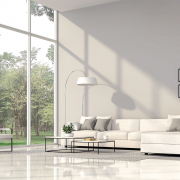Window glass – the alpha and omega of every nearly zero-energy building
Window glazing is usually the most neglected part of the building. Most architects and investors primarily deal with the appearance of the window and the function and material of window frames in an effort to minimize heat loss in window openings and meet the conditions imposed on buildings within the framework of the amendment for almost all zero-energy buildings.
Glass is, however, an indispensable part of every window pane, from which it makes up 85%! The design of windows and glass should be defined clearly and comprehensibly in the project documentation for the construction. It is the specific positioning of the window, the orientation of the object and the maximum size of the glass surface that are the determining factor for correct and informed selection of the window. And it is necessary to add that the definition of triple glazing with Ug = XY, which is often used in the project, is totally insufficient.
Choosing the right glass
The window, from a thermal insulation point of view is often considered to be the weakest link in the perimeter cladding, should be an integral part of the design of the entire structure from the very beginning. Especially glazing; it is part of the construction product and is subject to laboratory and computing assessment procedures. Requirements for glass and opaque fillings are determined by the specific design of the product, the place of installation in the building and the system principles. The properties given to it during production will subsequently define not only its energy efficiency during construction, but also the internal environment of the building and the feeling that users will have inside. That is why the cooperation of specialists from several areas is necessary already during the design of glass and any order should therefore be preceded by carefully and well-processed project documentation, which clearly defines which types of glass will be used in which parts of the house. From the point of safety, protection against noise and heat leakage and, of course, the volume of transmitted natural light and heat moving into the interior, it can be clearly stated that there are requirements for different types of glazing in the building and therefore it is impossible to use the same type of glass in all windows.
What should an architect or designer know?
In order to achieve a quality and well-lit interior, the architect and designer should work effectively not only with the size of the window, but also with its properties.
The key questions in choosing correct and suitable windows are the following:
- What are the client’s requirements for acoustics and airborne sound insulation Rw [dB]?
- What is the orientation of the object with respect to the cardinal points of the world?
- How will sun protection be solved in the building? Are outdoor blinds planned? Is it even possible to install blinds?
- What is the client’s requirement for light transmission TL [%]?
- What are the client’s expectations regarding visible external reflection Lr [%]?
- What are the security requirements – either from the client’s point of view or with regards to security?
- What are the requirements for the heat transfer through the glass, what heat transfer coefficient Ug through the glass is required and what is the required coefficient Uw for the whole window [W/m2K]?
Why is it necessary to start with acoustics?
Acoustics indirectly define the thickness of the glass and thus the desired profile. Unfortunately, it is never possible to choose glass that offers only the pluses – that means that it transmits light, but no heat. There is always a compromise to be reached. That is why when choosing each window in the house, it is important to consider what is most important for the users of the particular room.
One of the reliable innovative solutions that offer such a compromise is so-called insulating glass with a new generation of low-emission ECLAZ coatings from Saint-Gobain. Thanks to the innovative coating technology, insulating glass achieves above-average thermal insulation properties, high light transmission as well as high solar gains.
Glass as part of savings
So, it can be concluded that an ideal and correctly installed window with appropriately selected glass and quality frame should, depending on the orientation of the building, let into the interior as much light as possible, as much heat from the sun as possible and have the best possible thermal insulation properties – all under the assumption of functional exterior shielding. In short, it can be said that according to the strictest criteria at nZEB, the building cannot do without high-quality windows with responsibly and correctly selected glass specified on the basis of the expected properties.
PR




 Realizace tohoto administrativního projektu projektovaného ve standardu BIM, byla zahájena v dubnu 2017. Podrobněji nám ho přiblížil Ing. arch. Adam Cifra z DELTA Group.
Realizace tohoto administrativního projektu projektovaného ve standardu BIM, byla zahájena v dubnu 2017. Podrobněji nám ho přiblížil Ing. arch. Adam Cifra z DELTA Group. Projekt se začal připravovat v roce 2016 v BIM. Jaké byly v té době na Slovensku podmínky pro práci touto metodou?
Projekt se začal připravovat v roce 2016 v BIM. Jaké byly v té době na Slovensku podmínky pro práci touto metodou? Jak velké nároky měl EKOM při zadávání projektu, který od roku 2018 patří na Slovensku mezi ty průkopnické?
Jak velké nároky měl EKOM při zadávání projektu, který od roku 2018 patří na Slovensku mezi ty průkopnické?
 Systémová řešení harmonicky integrovaná do architektury
Systémová řešení harmonicky integrovaná do architektury Rozmanitost barev a povrchových úprav
Rozmanitost barev a povrchových úprav